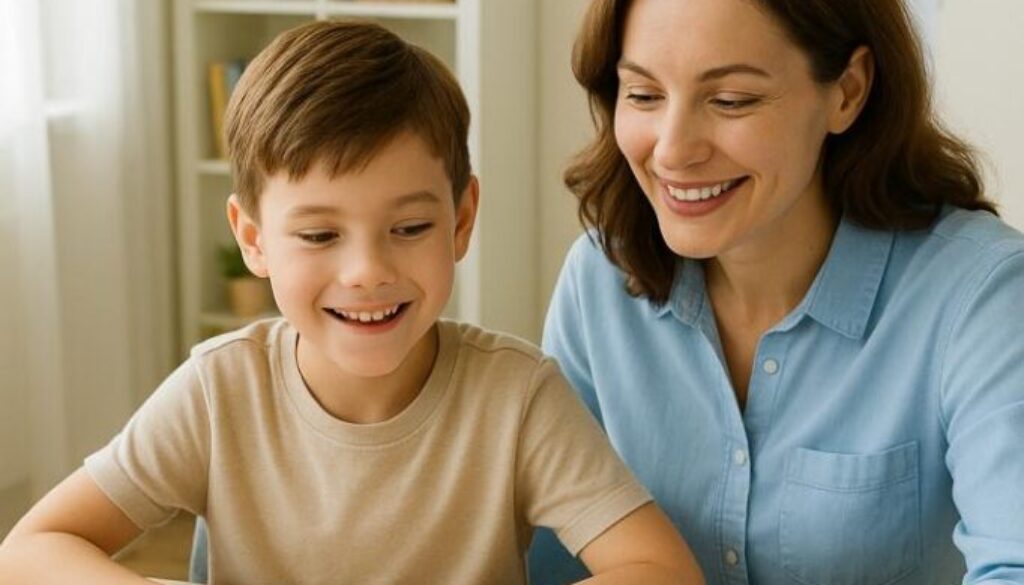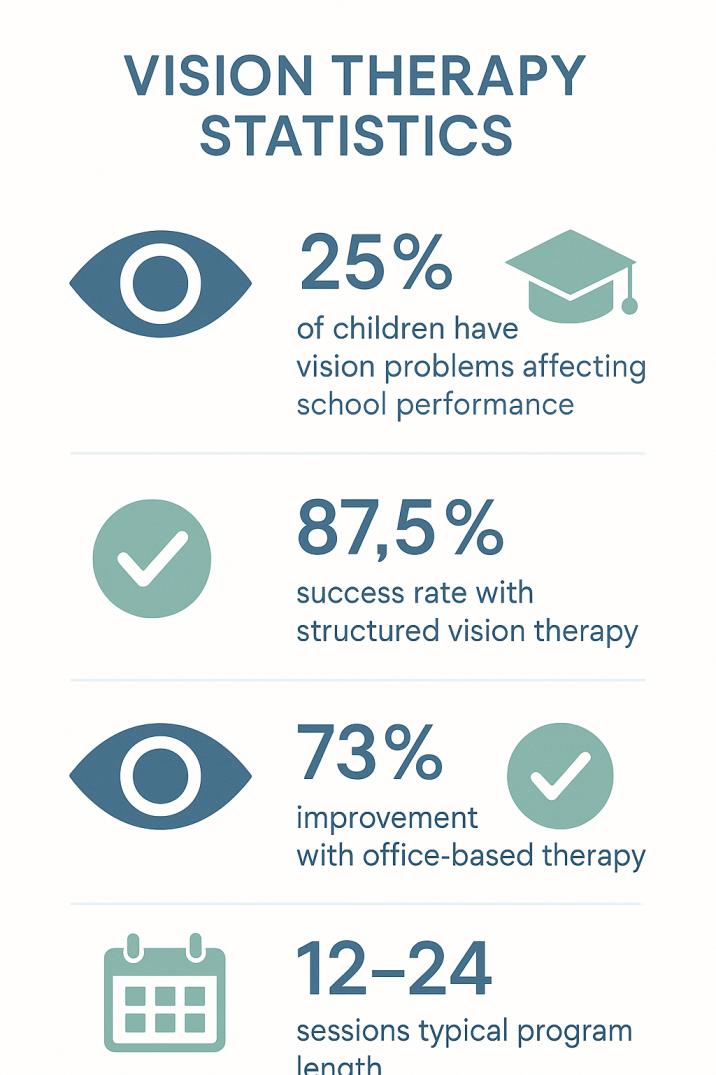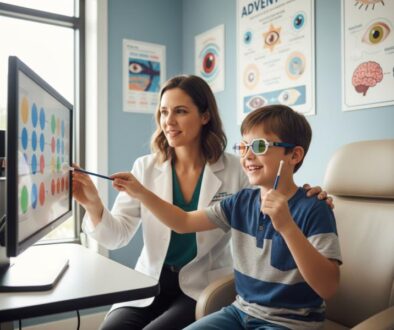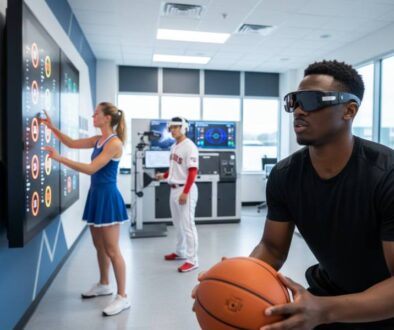How to Prepare Your Child for Vision Therapy: Expert Guide

Successfully learning how to prepare your child for vision therapy sets the foundation for treatment success and lasting visual improvement. This evidence-based guide provides essential strategies to prepare your child effectively, helping them feel confident, engaged, and ready to transform their vision therapy journey.
Understanding Vision Therapy: What Every Parent Should Know
Vision therapy is a specialized, doctor-supervised treatment program designed to improve visual skills and brain-eye coordination. Unlike glasses or surgery that address vision symptoms, vision therapy teaches the visual system to function more efficiently through targeted exercises and activities.
When you’re ready to prepare your child for vision therapy, it’s essential to understand that vision therapy is defined as a doctor-supervised, non-surgical, and customized program of visual activities designed to correct specific vision problems and/or improve visual skills. Think of it as physical therapy for your child’s visual system.
Quick Answer: What is Vision Therapy? Vision therapy is a doctor-supervised, non-surgical treatment program that uses targeted exercises and activities to improve visual skills and brain-eye coordination. Unlike glasses or surgery that compensate for vision problems, vision therapy teaches the visual system to function more efficiently.
Recognizing When Your Child Needs Vision Therapy
Understanding the indicators that suggest your child may benefit from vision therapy is paramount to ensuring timely intervention. Current research demonstrates that 25% of all children experience vision problems significant enough to impact their academic performance, with up to 1 in 4 school-aged children presenting with visual impairments that extend beyond simple refractive errors.
The process of learning how to prepare your child for vision therapy begins with recognizing the constellation of signs that indicate potential visual dysfunction. These manifestations often present as a complex interplay of academic, physical, and behavioral symptoms that, when viewed collectively, paint a picture of underlying visual processing difficulties.
Evidence-Based Assessment Checklist: Does Your Child Need Vision Therapy?
Academic Performance Indicators:
- Inconsistent reading fluency with frequent line-skipping or word omissions
- Comprehension difficulties despite demonstrated intelligence in other areas
- Active avoidance of homework or reading-intensive activities
- Recurrent headaches correlating with visual tasks or academic work
- Abbreviated attention span during activities requiring sustained visual focus
Physiological Manifestations:
- Monocular suppression (closing one eye) or head tilting during reading
- Reports of diplopia (double vision) or visual blur
- Excessive eye rubbing or signs of ocular irritation
- Rapid onset of visual fatigue during near-work activities
- Difficulties with visual-motor tasks, such as copying from the whiteboard
Behavioral and Developmental Observations:
- Spatial awareness deficits manifesting as clumsiness
- Challenges with ball sports require visual tracking and depth perception
- Balance and coordination difficulties during physical activities
- Strategic avoidance of visually demanding recreational activities
Clinical Note: The presence of three or more indicators warrants comprehensive vision evaluation by a qualified developmental optometrist.
The Critical Connection: Vision and Learning
Research consistently demonstrates that visual processing deficits often masquerade as learning disabilities. Children with undiagnosed vision problems may be misidentified as having attention deficit disorders, dyslexia, or other learning differences when the root cause lies in visual system dysfunction. This misidentification can lead to years of ineffective interventions and unnecessary academic struggle.
Step 1: Create a Positive Mindset About Vision Therapy {#step-1-positive-mindset}
Establishing the Optimal Therapeutic Foundation
Your approach and attitude toward vision therapy serve as powerful determinants of your child’s therapeutic experience and ultimate success. When you prepare your child for vision therapy, it is imperative to cultivate an atmosphere of optimism and anticipation rather than dwelling on deficits or expressing concern about existing challenges.
Research in pediatric psychology consistently demonstrates that parental attitudes significantly influence treatment outcomes. Children are remarkably attuned to their parents’ emotional states and will often mirror these sentiments throughout their therapeutic journey.
Age-Appropriate Communication Strategies
Early Childhood (Ages 4-7): Foundational Understanding. Employ concrete, imaginative language that resonates with young children’s developmental stage: “We’re going to engage in special eye games that will help your eyes become better teammates. Think of it as teaching your eyes to be the very best friends they can be!”
Elementary Age (Ages 8-12): Building Comprehension.n Provide clear, purpose-driven explanations: “Vision therapy involves training your eyes and brain to work together more effectively, which will make reading, sports, and schoolwork feel easier and more enjoyable.”
Adolescence (Ages 13+): Fostering Investment. Offer straightforward, benefit-focused information: “Vision therapy can significantly enhance your academic and athletic performance by optimizing how your visual system functions. Many students experience marked improvements in reading efficiency and comprehension.”
These developmentally appropriate explanations are fundamental components when you prepare your child for vision therapy success.
Psychological Preparation Strategies:
- Frame vision therapy as skill development rather than problem correction
- Emphasize the temporary nature of the program with lasting benefits
- Connect therapy to your child’s interests and goals
- Establish realistic timelines while maintaining optimistic expectations
Step 2: Schedule a Comprehensive Vision Evaluation
Finding the Right Professional
If the basic eye exam suggests that no glasses are needed, or there is no change in your child’s current eyeglasses prescription, or each eye has 20/20 visual acuity, be aware that a vision problem still may exist.
Look for an optometrist who specializes in:
- Vision therapy and development
- Pediatric vision care
- Binocular vision disorders
- Learning-related vision problems
Questions to Ask During the Evaluation:
- What specific vision problems has my child been diagnosed with?
- How long will the therapy program last?
- What improvements can we realistically expect?
- Will therapy include both office and home sessions?
- What is the expected timeline for seeing results?
- What does the total investment look like?
- How do we measure success?
Pro Tip: Bring a written list of your child’s symptoms and academic challenges to the appointment.
Step 3: Prepare Your Child Emotionally and Mentally
Building Excitement and Reducing Anxiety
When you prepare your child for vision therapy, addressing their emotional readiness is just as important as the practical aspects. Vision therapy success depends heavily on your child’s cooperation and enthusiasm.
Discuss the Process Openly: Explain what vision therapy involves in terms your child can understand. Describe it as a learning adventure rather than a medical treatment.
Address Common Concerns:
- “Will it hurt?” (No, vision therapy is completely painless)
- “How long will it take?” (Usually 3-6 months with regular sessions)
- “Will I still need glasses?” (Possibly, but your vision will work much better)
Set Realistic Expectations: Typical Timeline for Results:
- Initial improvements: Often noticed within 2-4 weeks of consistent therapy
- Significant progress: Usually seen within 8-12 weeks
- Complete program duration: Typically 12-24 office sessions over 4-9 months
- Individual variation: Each patient progresses at their own pace based on condition severity and compliance
- Long-term maintenance: 87.5% of children maintain improvements one year post-treatment
Create Positive Associations:
- Compare vision therapy to learning a new skill like riding a bike
- Emphasize the “training” aspect rather than “treatment”
- Focus on the benefits they’ll experience rather than the problems being fixed
This emotional preparation is a critical component when you prepare your child for vision therapy.
Step 4: Establish a Home Environment for Success
Creating the Ideal Practice Space
Designate a Quiet Area: Vision therapy will be more effective if it’s carried out in a quiet place, away from other family members. Choose a well-lit, distraction-free zone for home exercises.
Essential Setup Elements:
- Good lighting (natural light when possible)
- Comfortable seating at an appropriate height
- Adequate table space for materials
- Minimal visual distractions
- Easy access to therapy tools and equipment
Gather Necessary Supplies:
- Timer for exercise sessions
- Comfortable chair and table
- Good lighting (desk lamp if needed)
- Storage container for therapy materials
- Progress tracking chart or notebook
Step 5: Develop a Consistent Routine
The Power of Routine in Vision Therapy Success
Schedule regular time slots intended for vision therapy. You know your child best. Find a time in the day when they have the most attention. Furthermore, setting a routine means they know what to expect and will be more motivated to finish it.
Establishing a consistent routine is fundamental when you prepare your child for vision therapy, as regularity directly impacts treatment effectiveness.
Creating an Effective Schedule:
Daily Timing Strategies:
- Choose times when your child is most alert and focused
- Avoid scheduling immediately after school when they may be tired
- Consider morning sessions for better concentration
- Keep sessions short initially (10-15 minutes) and gradually increase
Weekly Planning:
- Aim for 5-6 days per week of home practice
- Schedule office visits at consistent intervals
- Plan around other activities and commitments
- Build flexibility for busy days
Sample Daily Routine:
- Review goals for the session (2 minutes)
- Warm-up exercise (3-5 minutes)
- Main therapy activities (10-20 minutes)
- Cool-down and review progress (2-3 minutes)
- Celebrate completion and effort
Step 6: Maximize Motivation and Engagement
Keeping Your Child Excited About Vision Therapy
Maintaining motivation throughout the vision therapy program is one of the most important aspects when preparing your child for vision therapy. Long-term success depends on sustained engagement and enthusiasm.
Gamification Strategies:
- Create a reward system for consistent practice
- Use stickers or charts to track progress
- Celebrate weekly milestones
- Let your child choose some activities when possible
Motivation Techniques by Age:
For Younger Children:
- Use character-themed rewards (favorite cartoon stickers)
- Create stories around the exercises
- Incorporate favorite toys or colors
- Make completion a celebration
For Older Children:
- Set goal-oriented rewards (extra screen time, special outings)
- Track improvements in real activities (reading speed, sports performance)
- Involve them in monitoring their progress
- Connect therapy to their interests and goals
Some exercises can prompt a decrease in motivation and frustration. Don’t forget to tell them they are doing a great job! Allow the child to have choices over exercises. They are more motivated when they can choose from different activities on their own.
Step 7: Partner with Your Vision Therapy Team
Building a Collaborative Relationship
Communication is Key:
- Maintain regular contact with your vision therapist
- Report progress and challenges honestly
- Ask questions about techniques and modifications
- Share observations about your child’s behavior and improvements
Home-Office Coordination:
- Follow prescribed exercise protocols exactly
- Report difficulties or modifications needed
- Attend all scheduled appointments
- Complete any required progress documentation
Involving Your Child’s School:
- Inform teachers about the vision therapy program
- Request understanding for any temporary reading difficulties
- Monitor improvements in classroom performance
- Coordinate with school support services if needed
Step 8: Monitor Progress and Maintain Momentum
Tracking Success Throughout the Journey
Observable Improvements to Watch For:
- Increased reading stamina and fluency
- Better handwriting and copying accuracy
- Improved sports performance and coordination
- Reduced complaints of headaches or eye strain
- Enhanced focus and attention during visual tasks
- Greater confidence in academic activities
Documenting Progress:
- Keep a daily log of exercise completion
- Note any changes in behavior or performance
- Record improvements in specific skills
- Track reduction in symptoms over time
- Celebrate milestones and achievements
Handling Setbacks:
- Understand that progress may not always be linear
- Communicate challenges promptly with your therapist
- Adjust expectations and timelines as needed
- Maintain consistent encouragement and support
- Focus on effort rather than just results
Understanding Vision Therapy Costs and Investment
Current Pricing (2024-2025 Data):
- Individual sessions: $125-$250 per session
- Complete programs: $2,800-$4,000 total (20-30 sessions)
- Evaluation: $200-$400 for comprehensive assessment
- Home therapy tools: $50-$200 for supporting materials
Insurance Considerations:
- Most insurance plans have limited coverage for vision therapy
- Some plans may cover medical conditions like convergence insufficiency
- Health Savings Accounts (HSAs) often cover vision therapy expenses
- Payment plans are typically available through vision therapy practices
Common Challenges and Solutions
Addressing Typical Obstacles
Challenge: Lack of Motivation
- Solution: Implement reward systems and celebrate small victories
- Tip: Let your child choose some aspects of their therapy routine
Challenge: Time Management
- Solution: Start with shorter sessions and gradually increase duration
- Tip: Integrate therapy into existing daily routines
Challenge: Difficulty with Specific Exercises
- Solution: Work closely with your therapist to modify techniques
- Tip: Break complex exercises into smaller, manageable steps
Challenge: Inconsistent Progress
- Solution: Maintain patience and consistent practice schedules
- Tip: Focus on effort and improvement rather than perfection
Current Vision Problems Statistics (2025)
Understanding the scope of vision problems in children helps emphasize the importance of proper preparation for vision therapy:
Global Prevalence:
- 450 million children globally have a sight condition requiring treatment
- 90 million children worldwide live with some form of vision loss
- 25% of all children have vision problems significant enough to affect school performance
- 80% of learning comes through the visual system
United States Data:
- 6.8% of children under 18 have a diagnosed eye and vision condition
- Strabismus affects 3.2% of the pediatric population (the most common eye disease)
- Amblyopia affects 1.5% of children (the second most common disorder)
- Only 63.5% of children aged 3-5 have ever had vision testing by a professional
Technology-Enhanced Vision Therapy Options
Modern Approaches to Traditional Therapy
Today’s vision therapy incorporates advanced technology to enhance engagement and effectiveness:
Digital Therapy Platforms:
- Interactive games that make therapy enjoyable
- Progress tracking through digital platforms
- Home-based therapy options with professional monitoring
- Customizable difficulty levels based on individual progress
Benefits of Technology Integration:
- Increased engagement and motivation
- Real-time progress monitoring
- Consistent exercise difficulty adjustment
- Better compliance tracking
- Fun, game-like experiences
Supporting Your Child’s Overall Development
Beyond Vision Therapy: Holistic Approaches
Lifestyle Factors That Support Vision Development:
- Adequate sleep for neural development
- Balanced nutrition, including omega-3 fatty acids
- Limited screen time with regular breaks
- Outdoor activities for natural light exposure
- Regular physical exercise for overall coordination
Complementary Activities:
- Reading together daily
- Puzzle and construction activities
- Ball games and sports activities
- Art and drawing projects
- Balance and coordination exercises
When to Seek Additional Support
Consider Additional Evaluation If:
- No improvement after 8-12 weeks of consistent therapy
- Your child shows signs of significant frustration or resistance
- Other learning or developmental concerns emerge
- Vision therapy goals aren’t being met within expected timeframes
Professional Resources:
- Educational specialists for learning support
- Occupational therapists for motor skills
- School counselors for emotional support
- Pediatricians for overall health evaluation
Additional Resources and Scientific References
Key Research Studies
-
Effectiveness of Vision Therapy in School Children with Symptomatic Convergence Insufficiency
Journal of Ophthalmic and Vision Research, 2017
https://www.ncbi.nlm.nih.gov/pmc/articles/PMC5423373/
This peer-reviewed study demonstrates 87.5% success rates for vision therapy in treating convergence insufficiency in elementary school children. -
Vision Therapy: A Primer and Caution for Pediatricians
Children’s Journal, November 2022
https://www.ncbi.nlm.nih.gov/pmc/articles/PMC9777217/
Comprehensive review of vision therapy effectiveness and evidence-based recommendations for pediatric care providers. -
Children’s Vision and Eye Health Statistics
Prevent Blindness Organization, 2024
https://preventblindness.org/common-childrens-vision-problems-prevalence/
Current prevalence data on vision disorders in children, including refractive errors, amblyopia, and strabismus, are available.
Professional Organizations
- College of Optometrists in Vision Development (COVD) – www.covd.org
- Optometric Extension Program Foundation – www.oepf.org
- International Association of Healthcare Professionals in Vision Development
Conclusion: Setting Your Child Up for Success
Preparing your child for vision therapy represents a pivotal investment in their visual development, academic achievement, and overall quality of life. Through the implementation of evidence-based preparation strategies—including the establishment of positive therapeutic relationships, consistent practice routines, and ongoing communication with your professional care team—you create the optimal foundation for transformative visual improvements.
The journey of vision therapy requires patience, dedication, and collaborative engagement among all stakeholders. As demonstrated by extensive clinical research, successful vision therapy outcomes are achieved through a comprehensive therapeutic process that depends upon the active participation of the prescribing clinician, the motivated patient, and—in pediatric cases—the committed involvement of parents and caregivers.
The benefits of your child’s vision therapy will extend far beyond the confines of the therapy environment, enhancing academic performance, athletic capabilities, self-confidence, and overall life satisfaction. With proper preparation and sustained support, vision therapy can serve as a transformative experience that unlocks your child’s complete visual potential and sets the stage for lifelong success.
Take Action Today
Ready to Get Started?
- Schedule a comprehensive vision evaluation with a qualified developmental optometrist.
- Download our preparation checklist to track your child’s readiness
- Learn more about vision therapy options in your area
- Connect with other parents who have successfully navigated vision therapy
Professional Consultation: The information presented in this guide serves educational purposes and should complement, not replace, professional medical advice. For personalized treatment recommendations and guidance specific to your child’s unique visual needs, consultation with qualified vision therapy professionals is essential.
FAQs
-
Vision therapy is a doctor-supervised program of exercises designed to improve eye coordination, tracking, and focusing skills in kids




